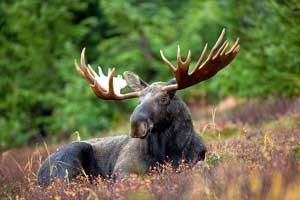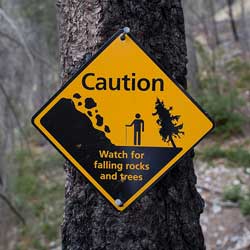
Source: Male Moose, Hagerty Ryan, Wikimedia

Source: Cougar closeup, Art G, Wikimedia
The two texts you will read are both about being outdoors. They are not just about going to a city park and playing Frisbee or going to a swimming pool and hanging out with friends. These are accounts of being outdoors when the characters or narrators can’t go inside, and Nature with a capital “N” is in charge; the people in the two texts must deal with the outdoors.
The first text is an excerpt from the short story “Love of Life” by Jack London. You may have read or at least heard of Jack London’s novel The Call of the Wild. London also wrote White Fang, The Sea Wolf, and many other novels and stories. London lived from 1876 to 1916 and did most of his writing after 1900, more than a hundred years ago. Yet his stories and novels do not feel particularly old-fashioned, perhaps because they primarily take place outdoors. The world of nature and the remote outdoors have not changed as much as the world of cities, living rooms, cars, and cell phones.
The second text, “How to Lick a Slug” by Nicholas Kristof, is an editorial piece from the New York Times. It also chronicles an experience outdoors, but you will discover that it’s quite different. This text is about a father and his daughter hiking on the Pacific Crest Trail. As you read it, think back to the London story (just as you might think back to Kristof’s text if you were on the Pacific Crest Trail). Make notations that will not only help deepen your understanding of this text but will also help you find similarities between it and the excerpt from the “Love of Life.” (You might want to look at Annotating for Meaning in the Related Resources to get ideas about how and what to mark.)

Source: Caution: Watch for falling rock and trees, runningclouds, Flickr
Hint #1: You should probably read the Jack London text first since it is slightly shorter. You will be able to keep the ideas of the shorter text in your mind more easily as you read the second text by Nicholas Kristof than if you did it the other way around.
Hint #2: Annotate (i.e., underline, circle, and make marginal notes) as you read to help you connect ideas in the two texts when you’re finished reading.
Hint #3: Everyone has his or her own way to annotate a text, but since this lesson is focused on reading and making connections between two texts, you might consider the following annotation strategy, designed specifically for paired passages:
- Read the shorter text carefully without marking anything or writing marginal notes.
- Read the longer text marking details, ideas, and described actions that could connect this text with the shorter, first text.
- Return to the first text and mark ideas, details, and actions that connect it to the second text.